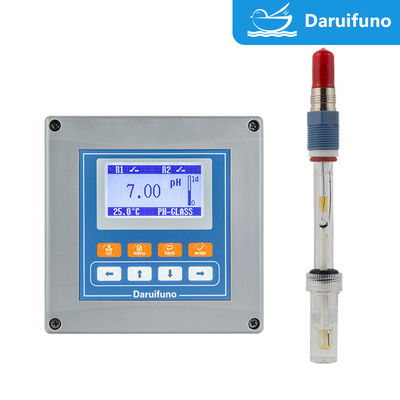5 Points Multi-Slope Calibration And Differential Signal Solution Ground Analog PH/ ORP Controller For Power Plant
The pH controller APX2-G4 is highly suitable for a wide range of application environments that require high-precision pH measurement, flexible control, historical data recording, and remote monitoring. It meets the demanding requirements for pH value accuracy and reliability.
Key Features and Advantages:
5-Point Calibration: The 5-point calibration ensures high-precision pH measurements, making it suitable for applications with stringent accuracy requirements.
Historical Data Storage Function: This feature allows for the recording of past pH data and events, enabling future analysis, review, and quality control.
Dual Relay Outputs: The dual relay outputs can be used for switch control, such as triggering alarms or executing other operations at specific pH levels, providing greater flexibility in system control.
Dual Current Outputs: The current outputs can transmit pH data to a PLC or data acquisition system for further processing and control.
One RS485 Communication Interface: The RS485 communication interface supports real-time monitoring and remote access, ensuring that you can monitor the pH values' status at any time.
Differential Signal Support: Differential signal support helps reduce signal interference, enhancing measurement accuracy.
Solution Grounding Support: Support for solution grounding helps ensure measurement stability and accuracy, particularly in electrochemical environments.
In summary, the APX2-G4 pH controller is well-suited for applications where precise pH measurement, flexible control, historical data storage, and remote monitoring are essential. It meets the stringent requirements for pH value accuracy and reliability, making it a valuable tool in various industries and research settings.
Specification:
| Model |
APX2-C3 |
APX2-G4 |
| Principle |
PH |
Glass pH electrode (hydrogen ion concentration index) |
| ORP |
Platinum or gold electrodes (redox potential) |
| Display Range |
PH |
0~14pH |
| ORP |
± 2000mV |
| Temp |
-10~150℃ |
| Solution Ground |
N/A |
Differential ground |
| Resolution |
pH: 0.01pH ORP: 1mV TEMP: 0.1℃ |
| Accuracy |
0.1% of the measuring range or ±0.02pH / ±2mV, take the larger one |
| Stability |
0.05% of measuring range every 24 hours without accumulation |
| Repeatability |
Better than 0.1% of measuring range |
| Temp Compensation |
Automatic or manual (NTC10K/PT1000) |
Automatic or manual (NTC10K/PT1000)
Converted at 25°C
|
| Relay Output |
Two SPST relays, Max. load 3A/250VAC, set high/low alarm, temp or clean control |
| Digital Communication |
A two-wire RS485, Modbus, JSON |
| Current Output |
Two 0/4~20mA current Max. load 1000Ω |
| Language |
English |
English and Chinese |
| Time Display |
Year/month/date hour/minute/second |
| Historical Data |
10000 historical data can be recorded,
Record the last 100 calibration maintenance data
|
| Display |
128*64 3.2-inch graphic dot matrix LCD |
| Calibration Method |
PH: 3 points; ORP: 2 points |
PH: 3 points; ORP: 2 points
PH: 5 points multi-slope calibration
|
| Protection Grade |
IP66 |
| Enclosure Material |
Enhanced ABS |
| Power Supply |
AC: 100~240V or DC:18~36V, 50/60Hz |
| Dimension |
144*144*120mm (Hole size 138*138mm) |
| Electrical Interface |
Reserve three M12*1.5 glan heads, the wire diameter is 3~6.5mm |
| Work Temperature |
0~60℃, RH<95%, non-condensing |
| Storage Temperature |
-20~70℃, RH<55%, non-condensing |
| Installation |
Wall mounting, pipe clamp, panel |
| Power Consumption |
Max. 3W |
Brief introduction:
- 3.2 inch LCD screen
- Time and historical data can be recorded
- Temperature compensation function
- 6 Password can be set
- 144*144*120mm dimension
- English interface
- Calibration points are adjust freely



The use environment includes but not limited to the following:
Laboratory environment:
pH and ORP sensors are commonly used in laboratories for chemical analysis, biological experiments and research applications. These environments are often tightly controlled to ensure high precision and accuracy.
Industrial production:
Chemical plants, pharmaceutical plants, food processing plants, and other industrial sites use pH and ORP sensors to monitor and control production processes. This helps ensure product quality, increase production efficiency and avoid unnecessary waste.
Environmental monitoring:
pH and ORP sensors are widely used in the field of environmental monitoring to detect and monitor the properties of water, soil, wastewater and pollutants. This helps protect the natural environment and human health.
Water treatment:
Drinking water treatment plants and wastewater treatment plants use pH and ORP sensors to monitor and regulate the pH and redox properties of water to ensure water quality is up to standard.
Pool and Spa:
pH sensors are used to monitor the pH level of swimming pool and spa water to maintain clean and safe water.
Agriculture:
The field of agriculture uses pH sensors to monitor the pH of the soil to determine the most suitable soil conditions for growing different crops.
Food and drinks:
The food and beverage processing industry uses pH sensors to monitor and regulate the pH of food products to ensure product safety and taste.
Aquarium:
pH and ORP sensors are used to monitor the quality of water in fish tanks, aquariums and aquarium exhibits to ensure the health of fish and aquatic life.
It should be noted that different applications may have different requirements for sensor accuracy, durability and environmental conditions. Therefore, when choosing pH and ORP sensors, you must consider the characteristics of the use environment and choose a suitable sensor model to ensure accurate and reliable measurement.

 Your message must be between 20-3,000 characters!
Your message must be between 20-3,000 characters! Please check your E-mail!
Please check your E-mail!  Your message must be between 20-3,000 characters!
Your message must be between 20-3,000 characters! Please check your E-mail!
Please check your E-mail! 








